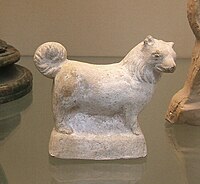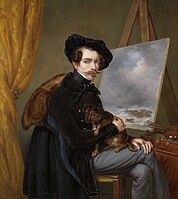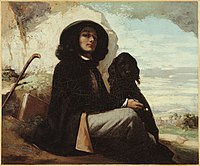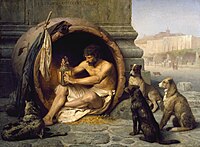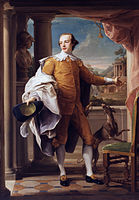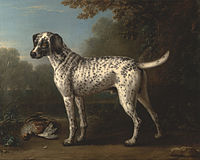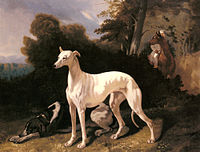Cultural depictions of dogs: Difference between revisions
OccultZone (talk | contribs) fix dead link |
OccultZone (talk | contribs) working link |
||
| Line 4: | Line 4: | ||
==Early history== |
==Early history== |
||
The prehistoric paintings of [[Bhimbetka rock shelters]] |
The prehistoric paintings of [[Bhimbetka rock shelters]] depicts dog on a [[leash]] with a man.<ref>{{cite book|title=Sacred Animals of India|page=101|first=Nanditha|last=Krishna|publisher=Penguin}}</ref> The walls of caves and tombs dating back to the [[Bronze Age]] have illustrations or statues of dogs. These generally portray dogs used for hunting.<ref>{{cite web|title=Dog|url=http://library.eb.co.uk/eb/article-15457|publisher=[[Encyclopædia Britannica]]|accessdate=24 September 2013}}</ref> Even children's toys and ceramics depicting dogs. |
||
<gallery widths="200px" heights="200px" perrow="5"> |
<gallery widths="200px" heights="200px" perrow="5"> |
||
| Line 33: | Line 33: | ||
In monarchies, the aristocracy are a class of people who either possess hereditary titles granted by a monarch or are related to such people, and thanks to the specific connection of the aristocrats with the hunting dogs, dogs were often shown as symbols in heraldry. In the late [[Middle Ages]] and the [[Renaissance]], [[heraldry]] became a highly developed discipline. Dogs of various types, and occasionally of specific breeds, occur as [[Charge (heraldry)|charges]] and [[supporter]]s in many [[coat of arms|coats of arms]], and often symbolise courage, vigilance, loyalty and fidelity.<ref>[http://web.archive.org/web/20120304224608/http://www.scottish-wedding-dreams.com/heraldic-animals.html ~ Heraldry Symbols]</ref> |
In monarchies, the aristocracy are a class of people who either possess hereditary titles granted by a monarch or are related to such people, and thanks to the specific connection of the aristocrats with the hunting dogs, dogs were often shown as symbols in heraldry. In the late [[Middle Ages]] and the [[Renaissance]], [[heraldry]] became a highly developed discipline. Dogs of various types, and occasionally of specific breeds, occur as [[Charge (heraldry)|charges]] and [[supporter]]s in many [[coat of arms|coats of arms]], and often symbolise courage, vigilance, loyalty and fidelity.<ref>[http://web.archive.org/web/20120304224608/http://www.scottish-wedding-dreams.com/heraldic-animals.html ~ Heraldry Symbols]</ref> |
||
Three [[encaustic tile]]s dating from the 15th century featured a white hound, the Talbot family crest and the inscription "Sir John Talbot" (the [[John Talbot, 1st Earl of Shrewsbury|1st Earl of Shrewsbury]]). Part of a set of four, the tiles were possibly originally used on a church floor. The term talbot is used in heraldry to refer to a good-mannered hunting dog. The [[Talbot (dog)|Talbot dog]] always depicts the Talbot [[coat of arms]] and is the original hound used as an English heraldic symbol. It is portrayed in the family crest of several noble German families and at least seven other English families.<ref>{{cite news|last=Waters|first=Nick|title=History of the Talbot tiles|url=http://www.dogworld.co.uk/product.php/2223/Features/35-Waters-(2)|accessdate=18 January 2014|newspaper=[[Dog World (newspaper){{!}}Dog World]]|date=5 November 2010 |
Three [[encaustic tile]]s dating from the 15th century featured a white hound, the Talbot family crest and the inscription "Sir John Talbot" (the [[John Talbot, 1st Earl of Shrewsbury|1st Earl of Shrewsbury]]). Part of a set of four, the tiles were possibly originally used on a church floor. The term talbot is used in heraldry to refer to a good-mannered hunting dog. The [[Talbot (dog)|Talbot dog]] always depicts the Talbot [[coat of arms]] and is the original hound used as an English heraldic symbol. It is portrayed in the family crest of several noble German families and at least seven other English families.<ref>{{cite news|last=Waters|first=Nick|title=History of the Talbot tiles|url=http://www.dogworld.co.uk/product.php/2223/Features/35-Waters-(2)|accessdate=18 January 2014|newspaper=[[Dog World (newspaper){{!}}Dog World]]|date=5 November 2010}}</ref> |
||
==16th and 17th century== |
==16th and 17th century== |
||
Revision as of 05:38, 16 January 2015

Cultural depictions of dogs extends back to thousands of years when dogs were portrayed on the walls of caves. Representations of dogs in art became more elaborate as individual breeds evolved and the relationships between human and canine developed. Hunting scenes were popular in the Middle Ages and the Renaissance. Dogs were depicted to symbolize guidance, protection, loyalty, fidelity, faithfulness, watchfulness and love.[1] As dogs became more domesticated, they were shown as companion animals, often painted sitting on a lady's lap. Dog portraits became increasingly popular in the 18th century and the establishment of The Kennel Club in the UK in 1873 and the American Kennel Club in 1884 introduced breed standards or 'word pictures', which further encouraged the popularity of dog portraiture.
Early history
The prehistoric paintings of Bhimbetka rock shelters depicts dog on a leash with a man.[2] The walls of caves and tombs dating back to the Bronze Age have illustrations or statues of dogs. These generally portray dogs used for hunting.[3] Even children's toys and ceramics depicting dogs.
-
Cave canem! Watchdog from Casa di Paquius Proculus.
-
Dog on Wheeled Platform Veracruz Mexico
-
Roman terracotta dog
-
China Green glazed pottery dog
Middle ages

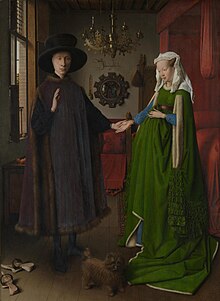
Generally, dogs symbolize faith and loyalty.[4] A dog, when included in an allegorical painting, portrays the attribute of fidelity personified.[5] In a portrait of a married couple, a dog placed in a woman's lap or at her feet can represent marital fidelity. If the portrait is of a widow, a dog can represent her continuing faithfulness to the memory of her late husband.[4]
An example of a dog representing marital fidelity is present in Jan van Eyck's "Arnolfini Portrait." An oil painting on oak panel dated 1434 by the Early Netherlandish painter Jan van Eyck, it is a small full-length double portrait,[6] which is believed to represent the Italian merchant Giovanni di Nicolao Arnolfini and his wife,[7] presumably in their home in the Flemish city of Bruges. It portrays a wedding scene, where the people invited to witness the ceremony can be seen in the convex mirror at the back, the mirror symbolizing the eye of God. In those times people were not always married in the church, it was enough that two witnesses were present to make a wedding legal. A number of symbols can be found in the picture: the fruit, the symbol of fertility and wealth, the shoes removed (this is a holy place), and the dog. The oranges casually placed to the left are a sign of wealth; they were very expensive in Burgundy, and may have been one of the items dealt in by Arnolfini. The little dog symbolizes in the Middle Ages iconography faithfulness, devotion or loyalty,[6] or can be seen as an emblem of lust, signifying the couple's desire to have a child.[8] Unlike the couple, the dog looks out to meet the gaze of the viewer.[9] The dog could also be simply a lap dog, a gift from husband to wife. Many wealthy women in the court had lap dogs as companions. In that case the dog could reflect wealth or social status.[10] During the Middle Ages, images of dogs were often carved on tombstones to represent the deceased's feudal loyalty or marital fidelity.[11]
Hunting scenes


Hunting scenes were common topics in medieval and Renaissance art. Hunting in the medieval period was a sport exclusive to the aristocracy and hunting was an essential part of court etiquette. The hunting dogs were connected to aristocracy. Hunting was considered as a sport, but also a way of showing bravery, chivalric virtue while hunting dangerous prays such as wild boars and bears. Hunting dogs allow humans to pursue and kill prey that would otherwise be very difficult or dangerous to hunt. Different breeds of dogs were used for different types of hunting. Hunting with dogs was so popular that during the Middle Ages the wild bears had already been hunted to extinction in England.
Even as animal domestication became relatively widespread and after the development of agriculture, hunting was usually a significant contributor to the human food supply. Hunting filled also a practical necessity, assuring food for the tables of the nobility. Nobles spending their money on packs of specially bred hounds were not unusual. Gaston Phoebus (30 April 1331 – 1391) wrote a manual on hunting and there are several tapestries from the period which depict hunting scenes.[12] Even if nobility was hunting, hunting has been forbidden to servants, peasants and also the Roman Catholic Church clerics. Thus the Corpus Juris Canonici (C. ii, X, De cleric. venat.) says, "We forbid to all servants of God hunting and expeditions through the woods with hounds; and we also forbid them to keep hawks or falcons." The Fourth Council of the Lateran, held under Pope Innocent III, decreed (canon xv): "We interdict hunting or hawking to all clerics." The decree of the Council of Trent is worded more mildly: "Let clerics abstain from illicit hunting and hawking" (Sess. XXIV, De reform., c. xii), which seems to imply that not all hunting is illicit, and canonists generally make a distinction declaring noisy (clamorosa) hunting unlawful, but not quiet (quieta) hunting. Thus, hunting dogs are seldom seen depicted in the company of clerics, but very often in the company of in the highest social class of that society.
In heraldry


In monarchies, the aristocracy are a class of people who either possess hereditary titles granted by a monarch or are related to such people, and thanks to the specific connection of the aristocrats with the hunting dogs, dogs were often shown as symbols in heraldry. In the late Middle Ages and the Renaissance, heraldry became a highly developed discipline. Dogs of various types, and occasionally of specific breeds, occur as charges and supporters in many coats of arms, and often symbolise courage, vigilance, loyalty and fidelity.[13]
Three encaustic tiles dating from the 15th century featured a white hound, the Talbot family crest and the inscription "Sir John Talbot" (the 1st Earl of Shrewsbury). Part of a set of four, the tiles were possibly originally used on a church floor. The term talbot is used in heraldry to refer to a good-mannered hunting dog. The Talbot dog always depicts the Talbot coat of arms and is the original hound used as an English heraldic symbol. It is portrayed in the family crest of several noble German families and at least seven other English families.[14]
16th and 17th century
During the 16th and 17th century, dogs were depicted in hunting scenes, or depicted representing social status, as a lap dog, or sometimes as a personal friend. They may also used as symbols in painting. The Greek philosopher Diogenes (404-323 BC) was depicted by Jean-Léon Gérôme, in the company of dogs that also served as emblems of his "Cynic" (Greek: "kynikos," dog-like) philosophy, which emphasized an austere existence.[15] Diogenes stated that "Unlike human beings who either dupe others or are duped, dogs will give an honest bark at the truth. Other dogs bite their enemies, I bite my friends to save them." [16] The Greek philosopher is seated in his abode, the earthenware tub, - also depicted sometimes in sitting in a barrel, - in the Metroon, Athens, lighting the lamp in daylight with which he was to go in searching for an honest man.
Hendrik Martenszoon Sorgh portrayed probably a scholar noted by its significance to its particular profession, depicting a book, or a Protestant preacher and theologian with the Bible opened on the table. A dog depicted as a companion to the scholar is a symbol of fidelity, vigilance and regularity in the research due to assigned to dogs natural intelligence and intuition, and the parrot is a symbol of erudition and eloquence.[16][17]
-
Painting by Hendrik Martenszoon Sorgh, a Dutch scholar sitting with his dog and parrot.
-
Self Portrait, by Louis Meijer. The painter's dog sits on his lap.
-
Gustave Courbet, Self-portrait with black spaniel dog.
-
Jean-Léon Gérôme. Diogenes with dogs.
-
Sir Edward Hales, Baronet, of Hales Place, Hackington, Kent with his dog, by Philippe Mercier
-
Unknown artist, portrait of a man with a beer, kite and his dogs.
-
Pompeo Batoni (1708–1787) Portrait of Sir Wyndham Knatchbull-Wyndham with a whippet
-
Anthony van Dyck The five eldest Children of Charles I of England with two dogs
18th–century
The tradition of showing dogs in hunting scenes continued through to the 18th–century.[18]
19th and 20th century
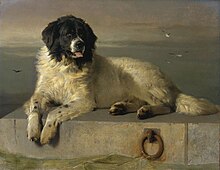

The picture entitled A Distinguished Member of the Humane Society depicts a dog that was well known in London at that time. The dog depicted by Sir Edwin Landseer 1838, was a Newfoundland called "Bob", who was found in a shipwreck off the coast of England. The dog found his way to the London waterfront where he became known for saving people from drowning, a total of twenty–three times over the course of fourteen years. For this, he was made a distinguished member of the Royal Humane Society, granting him a medal and access to food.[19] The Newfoundlanders with white patches are now recognized as a breed of their own, as a "Landseer".[20] The painting was described by The Art Journal 1838 as being "one of the best and most interesting publications of the year", and "Mr Thomas Landseer's first great effort in this department of the art".[21] A 19th century copy of the painting by George Cole was sold by auctioneers Bonhams for £7,200 in March 2007.[22]
By the Victorian era, the mainly sporting tradition remained but after the establishment of The Kennel Club in the UK in 1873 and the American Kennel Club in 1884 introduced breed standards or 'word pictures', dog portraits soared in popularity.[18] There were differences between the British and European style of depiction; William Secord, a world expert on canine art,[23] described it by stating: "Belgian, Dutch, Flemish and German artists were more influenced by realism, depicting the dog the way it really looked, with dirt on it’s coat and slobber and that kind of thing. You see Alfred Stevens, who's Belgian, do street dogs and dogs that are suffering, which in England you never see. British depictions were more idealized. They want it pretty.”[24]
Contemporary
The prices achieved for canine art increased the 1980-90s and started to gain popularity in established art circles rather than antique markets. Buyers can generally be divided into three dominant categories: hunters; breeders and exhibitors of pedigree dogs; and owners of companion animals.[25]
Pablo Picasso frequently included his canine companions in his paintings.[26] Particularly well known and often featured in his work was a Dachshund, named Lump, who actually belonged to David Douglas Duncan but lived with Picasso.[27]
Gallery
-
Johann Christof Merck, dog with a collar, 1705
-
Gerrit Dou, Sleeping Dog, 1650
-
John Wootton (1682–1764) A Grey Spotted Hound
-
White dog by Alexandre-François Desportes (1661–1743)
-
Puppies by Carl Reichert (1836–1918)
-
Little Terrier by Frederick August Wenderoth, 1875
-
A Greyhound with landscape by Alfred Dedreux (1810–1860)
-
Dash, a setter in a wooded landscape, by Jacques-Laurent Agasse (1767–1849)
See also
References
- ^ "Animal Symbolism in Many Cultures".
- ^ Krishna, Nanditha. Sacred Animals of India. Penguin. p. 101.
- ^ "Dog". Encyclopædia Britannica. Retrieved 24 September 2013.
- ^ a b Hall, James (1979), Dictionary of Subjects and Symbols in Art, Harper & Row, ISBN 978-0-06-430100-8
- ^ Kleiner, Fred S. (2009). Gardner's Art through the Ages: The Western Perspective. Wadsworth Publishing Company. p. 402.
- ^ a b Erwin Panofsky published an article entitled Jan van Eyck's 'Arnolfini' Portrait in the Burlington Magazine 1934
- ^ Stockstad Cothren
- ^ as the art historian Craig Harbison has argued
- ^ Harbison, Craig, Jan van Eyck, The Play of Realism, Reaktion Books, London, 1991, ISBN 0-948462-18-3 pp. 33–34
- ^ Harbison, Craig, "Sexuality and social standing in Jan van Eyck's Arnolfini double portrait", Renaissance Quarterly, volume 43, issue 2, p. 270, Summer 1990, JSTOR
- ^ Keister, Douglas (2004). Stories in Stone: A Field Guide to Cemetery Symbolism and Iconography. Salt Lake City, UT: Gibbs Smith. p. 72.
- ^ "Medieval and renaissance hunting". Victoria and Albert Museum. Retrieved 24 September 2013.
- ^ ~ Heraldry Symbols
- ^ Waters, Nick (5 November 2010). "History of the Talbot tiles". Dog World. Retrieved 18 January 2014.
- ^ Cf. Plato, Republic Book II
- ^ a b Diogenes of Sinope, quoted by Stobaeus, Florilegium, iii. 13. 44.
- ^ "Logical Rudeness"
- ^ a b "Victorian England". William Secord Gallery. Retrieved 24 September 2013.
- ^ "The Newfoundland in Art & Literature". Newfoundland Club of America. Retrieved 10 September 2011.
- ^ Story, George M. (1990). Dictionary of Newfoundland English. Toronto: Univ. of Toronto Press. p. 344. ISBN 978-0-8020-5887-4.
- ^ The Art Journal. Vol. I. London: The Art Union. 1839. p. 173.
- ^ "Lot Details: A Distinguished Member of The Humane Society". Bonhams. Retrieved 10 September 2011.
- ^ "Dog Art A Muse to Artists and a Delight to Countless Viewers". Ralph Lauren Media. Retrieved 23 November 2013.
- ^ "Dog Art: The Dog Has Been a Muse to Countless Artists and a Delight to Viewers". Art & Antiques. Archived from the original on 23 November 2013. Retrieved 24 September 2013.
{{cite web}}: Unknown parameter|deadurl=ignored (|url-status=suggested) (help) - ^ Silberman, Vanessa (May 2001). "Who Let the Dogs Out?". Art Business News. 28 (5). Retrieved 24 September 2013.
- ^ "Dogs in art". Purina. Retrieved 24 September 2013.
- ^ Coren, Stanley. "Picasso's Dogs". Modern Dog Magazine. Retrieved 23 November 2013.



